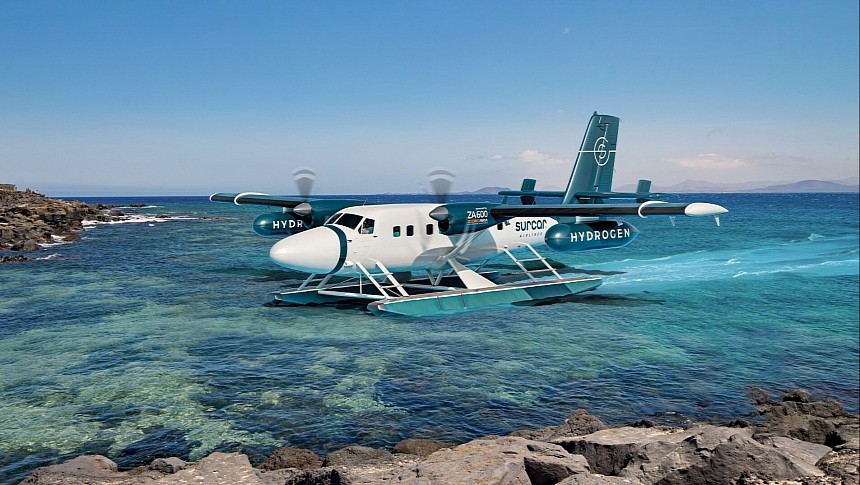While we wait for brand-new generations of aircraft to completely revolutionize air mobility and replace old, polluting fleets, existing commercial aircraft can get a green makeover through retrofit projects. The promising ZA600 hydrogen-electric powertrain is breathing new life into the classic Twin Otter seaplane.
Spain is one of the European countries planning to reach carbon-neutral transportation by 2050. It's a long way to go, but young companies like Surcar Airlines are already making a difference. This aviation operator wants to provide 100% green flights shortly. For now, it's working with conventional aircraft but hopes to replace them as soon as possible with zero-emission alternatives.
The new airline is betting on hydrogen, not in the form of new aircraft designed from scratch with a clean propulsion system, but in retrofitting existing ones, specifically, the Twin Otter seaplane.
This iconic STOL (short take-off and landing) launched by the De Havilland Aircraft Company of Canada has been successfully operating since the early '70s. As its name suggests, it was a twin-engine turboprop designed to replace the single-engine DHC-3 Otter.
Surcar Airlines wants to retrofit the Twin Otter with a hydrogen-electric powertrain that will drastically cut emissions. It's the ZA600, a 600 kW engine developed by ZeroAvia specifically for regional aircraft with nine to 19 seats.
ZeroAvia is headquartered both in the US and the UK, where it conducted simultaneous test campaigns using two Dornier 228 aircraft. The ZA600 promises a 300-mile (482 km) range, which makes it suitable for island-hopping operations.
The Spanish operator intends to use the retrofitted Twin Otter seaplanes for green tourist transportation in the Canary Islands. Its bold vision is to one day offer only zero-emission flights for this popular destination. At the moment, the ZA600 is still working to obtain its certification. ZeroAvia hopes to launch commercial services by 2025.
Only last month, ZeroAvia completed an extensive testing campaign in the UK that totaled ten flights of the Dornier 228 retrofitted with the ZA600 powertrain. The campaign included a record-breaking flight during which the Dornier reached an altitude of 5,000 feet (1,524 meters) and flew for approximately 20 minutes.
The goal was to demonstrate that the ZA600 could offer the same capabilities of a conventional fuel engine, with the added benefit of zero emissions. Throughout the UK testing program, the 228 used the ZA600 in one wing and a standard engine in the other for effective comparison.
The ZA600 for regional aircraft will be just the beginning. It will be shortly followed by the ZA2000, an even more powerful alternative for large airliners with 40 to 80 seats, promising a 700-mile (1,126 km) range.
ZeroAvia has secured numerous orders for the ZA600, including a hefty one from American Airlines.
The new airline is betting on hydrogen, not in the form of new aircraft designed from scratch with a clean propulsion system, but in retrofitting existing ones, specifically, the Twin Otter seaplane.
This iconic STOL (short take-off and landing) launched by the De Havilland Aircraft Company of Canada has been successfully operating since the early '70s. As its name suggests, it was a twin-engine turboprop designed to replace the single-engine DHC-3 Otter.
Surcar Airlines wants to retrofit the Twin Otter with a hydrogen-electric powertrain that will drastically cut emissions. It's the ZA600, a 600 kW engine developed by ZeroAvia specifically for regional aircraft with nine to 19 seats.
ZeroAvia is headquartered both in the US and the UK, where it conducted simultaneous test campaigns using two Dornier 228 aircraft. The ZA600 promises a 300-mile (482 km) range, which makes it suitable for island-hopping operations.
The Spanish operator intends to use the retrofitted Twin Otter seaplanes for green tourist transportation in the Canary Islands. Its bold vision is to one day offer only zero-emission flights for this popular destination. At the moment, the ZA600 is still working to obtain its certification. ZeroAvia hopes to launch commercial services by 2025.
Only last month, ZeroAvia completed an extensive testing campaign in the UK that totaled ten flights of the Dornier 228 retrofitted with the ZA600 powertrain. The campaign included a record-breaking flight during which the Dornier reached an altitude of 5,000 feet (1,524 meters) and flew for approximately 20 minutes.
The goal was to demonstrate that the ZA600 could offer the same capabilities of a conventional fuel engine, with the added benefit of zero emissions. Throughout the UK testing program, the 228 used the ZA600 in one wing and a standard engine in the other for effective comparison.
The ZA600 for regional aircraft will be just the beginning. It will be shortly followed by the ZA2000, an even more powerful alternative for large airliners with 40 to 80 seats, promising a 700-mile (1,126 km) range.
ZeroAvia has secured numerous orders for the ZA600, including a hefty one from American Airlines.







